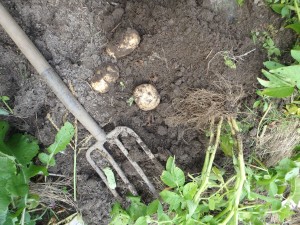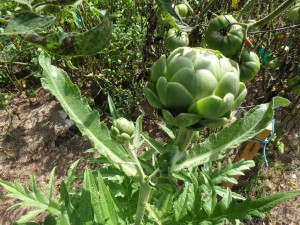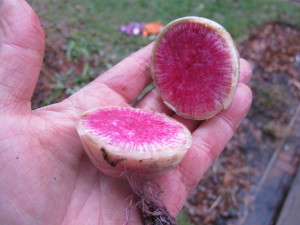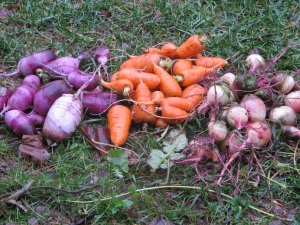It’s Harvest Time!
My garden is finally paying me back for all the work I’ve done this year. I’m putting up the harvest and eating vegetables until they (almost) pop out of my ears. It’s been a great summer.
Let’s look at how to know if your vegetables are ready to harvest, as it’s not always obvious. Potatoes, for example, are not obvious – the tubers are underground. The earlier you harvest, of course, the smaller the potatoes. But you can snitch a few after they have bloomed. If you have loose fluffy soil you can poke your hand into the soil under a plant and grab a spud without disturbing the plant – or the other potatoes that are still growing. Or you can dig up one plant and leave the others to grow.
To avoid damaging potatoes at harvest time, plunge a garden fork into the soil a foot from the plant, tip it back, and the roots – spuds and all- will be visible. Grab ‘em, but place gently in a bucket so as not to damage the still tender skins. Harden off in a cool, dark place – and leave the soil on if you want to store them.
Generally I let potatoes grow through September, harvesting only after the leaves have yellowed and died back. But I keep testing to see if they have reached the size I like. Some varieties develop hollow spots in the center if they get too big. That’s not a big issue for me. But I don’t want them too small and I generally start mine in June, long after most gardeners have started theirs. I do that to minimize potato beetle damage, and it seems to work. I didn’t see one beetle this year!
I grew artichokes again this year, though I don’t always. It is often hard to know when to pick them – an immature artichoke looks exactly like a mature one, but for the size. Same color, same feel if you squeeze them. But if you wait too long, the leaves get hard and unappealing. I picked my first ‘choke when it was about 3 inches across and didn’t seem to be getting bigger. That plant also produced a second flower (artichokes are actually flowers), and I picked it when it was about half the size. Again, it seemed to have stopped growing.
Summer squash can be picked at any size from tiny to mammoth. My favorite variety is ‘Romanesco’, which has stripes along its ribbed sides. I like it small, but it is still good to eat even if it “escapes” and gets huge. I just take a big spoon and scrape out the seeds. Generally I grate the big ones in my food processor and freeze the results in zipper bags for use in winter soups. I don’t blanch the squash, but do try to use it within a few months. Blanching kills enzymes that promote aging, while freezing does not. So squash is less appealing after months in the freezer.
It is tougher to know when winter squash is ready to pick. In general it is best to let winter squash like butternuts and hubbards stay on the vine until the leaves start to yellow and the stems turn brown and dry. But the best test is what I call the “fingernail” test: push your thumbnail against the skin. It should be tough enough that your nail leaves no mark. If you feel it digging in, stop pushing your nail against it.
When picking winter squashes or pumpkins, bring a sharp knife or a pair of pruners so that you can cut the stem, leaving a 3 inch “handle”. But don’t carry it by the handle, as you don’t want it to pull off. Most winter squashes also need some time in a warm sunny place to cure after being picked. Acorn squashes should go directly to a cool location, as they can get stringy if left in the sun. Always store winter squash in a low humidity area.
Never, I repeat never, let winter squash get frosted. If you don’t want to harvest them and frost is forecast, pull the comforter off you bed and cover them up. Or use an old sheet, I suppose, or even a plastic tarp.
Speaking of frost, which I hope is still weeks away, here are some veggies that will not survive even a light frost: basil, beans, cucumbers, eggplants, peppers, tomatoes and squash of all types.
On the other hand, plants that survive light frost include artichokes, beets, carrots, cauliflower, celeriac, lettuce, parsnips and Swiss chard. Plants that can still thrive after a hard frost include broccoli, Brussels sprouts, cabbage, kale, kohlrabi, parsley, radishes, spinach, turnips and leeks. I often pick kale and Brussels sprouts in December.
My onions were ready to harvest weeks ago. I know when they are ready to pull because the tops flop over. I cure them in a warm sunny place outdoors until the tops dry up. I store them, along with winter squash, in a low-humidity cool location indoors.
Growing vegetables really is for cooks. I probably would only grow flowers if I didn’t love fresh veggies so much. And of course being able to store and use my vegetables all year makes all that work even more worthwhile.
Want to have big Brussels sprouts? Read Henry’s blog for a 10-second trick: https://dailyuv.com/news/
Working in the Rain
After a cold snap recently we had 3 days of cold rain. By the second day, with no relief in sight, I went out to my garden and dug up the last of my root crops – carrots, watermelon radishes and purple daikon radishes. I figured that I’d better get them out of the ground while the getting was good. I came back wet and muddy, but feeling much more cheerful than before I went to the garden.
By day three, I was positively squirrely. I needed to do something outdoors. So I got dressed for an extended time in the garden: I layered on some Ibex brand wool long johns, two layers on top, and one on the bottom. Ibex makes its products from Merino wool, so they are not scratchy and seem to last forever. Then I put on rain pants and an LL Bean Gortex raincoat that keeps me dry and helps keep me warm. Rubber-palmed stretchy garden gloves protected my hands. Finally, I put on wool socks and my insulated Muck brand boots. I was ready.
I often warn gardeners not to walk on the garden soil when it is wet for fear of compacting it and ruining its structure. But I had some raised beds in the vegetable garden where I had harvested root crops – but not the late-season weeds that were there. I figured that so long as I worked carefully and never stepped off the walkways that I’d be fine.
I used a garden fork to loosen the soil near tap-rooted dandelions, then carefully tugged them out. How had so many escaped my notice? Well, I guess it was the “late-season weed blindness” that many of us suffer from. It is often spring before I notice certain weeds – because they’re blooming.
I did know, however, that I had a fair amount of chickweed (Stellaria media) in my garden, as that weed grows whenever the ground is not frozen – including early and late in the growing year. I once interviewed author David Mas Masumoto (author of Epitaph for a Peach) who told me that chickweed is a ”good weed”. It’s good because it blooms early and beneficial insects like ladybugs depend on its nectar for food before the aphids turn up as lunch.
Chickweed is a low-growing annual that has very small pointed leaves, each only a quarter to half an inch in length. The flowers – and mine are present now – are small and white; on cold rainy days, the flowers are just like me – buttoned up tightly. With a hand lense or field scope you can see that it has fine hairs on only one side of the stem in a single band. It pulls easily, and best of all, it is edible in salads! I think it tastes like mache or miner’s lettuce – okay to mix in, but not as a prime salad ingredient.
After about 15 minutes my hands were cold, so I went in and found my Ibex glove liners, which solved the problem. Wool is warm, even if wet. And I put on another layer of socks, and that kept my feet warm, too.
I buy composted cow manure by the truckload, and still have a supply left from last spring’s delivery. So after weeding out two small beds I brought down a couple of wheelbarrows of compost, spread it on top of the beds and gently stirred it into the top few inches with a long-handled potato fork.
I grow my vegetables in beds that are mounded up, or occasionally boxed in with planks. In either case, plants take out soil ingredients, and every time you pull a weed (or carrot) some soil goes with the roots, no matter how careful you are. So beds need new soil or compost added each year to keep their size.
Once the beds were all prepared for spring, I found some lawn that had been covered with late-falling leaves – oaks. Oaks are among the last to shed their leaves, and so had escaped earlier raking. I gathered them up and used them to cover the beds.
During this period of cold, cloudy, dark, damp, dismal miserable weather I collected some greenery to use in vases this winter. Pachysandra is a common shade groundcover that will look good all winter in a vase of water. In fact, it will even set out roots into the water. Just keep the leaves out of the water, and change the water from time to time. It doesn’t need to be on a sunny window, and can complement any flower arrangement you buy at the store. So I picked some and brought it in.
What else did I do during the week of wet weather? I did a little pruning – nothing major, no ladders, I just tuned up a few shrubs and a small tree. I have a common ninebark, one called ‘Diablo’, which looks as neat as an unmade bed right now. But I resisted the urge to prune it as I know it blooms early in the summer, and pruning it now would remove the flower buds. Lilacs, forsythia, and rhododendrons: all these and more have their buds ready for spring. Some flowers I can sacrifice, others not.
So if you get tired of being indoors, go ahead, dress up warmly and get out there – even if it’s raining. It’s very restorative.
Henry can be reached at P.O. Box 364, Cornish Flat, NH 03746 or by email at henry.homeyer@comcast.net. Please include a SASE if you wish a reply to questions by regular mail.








